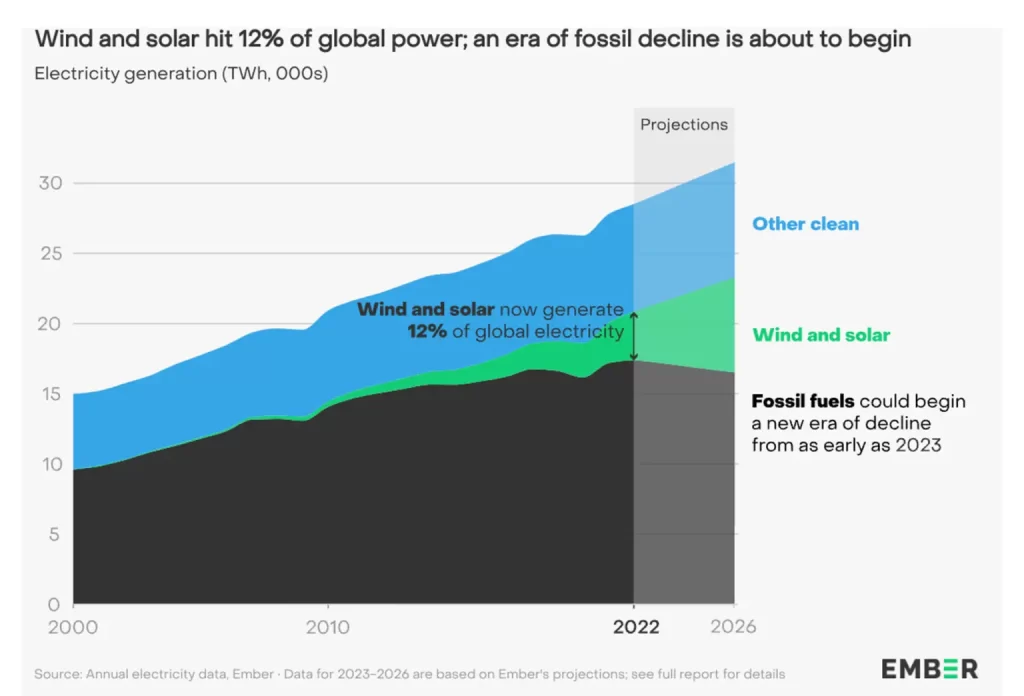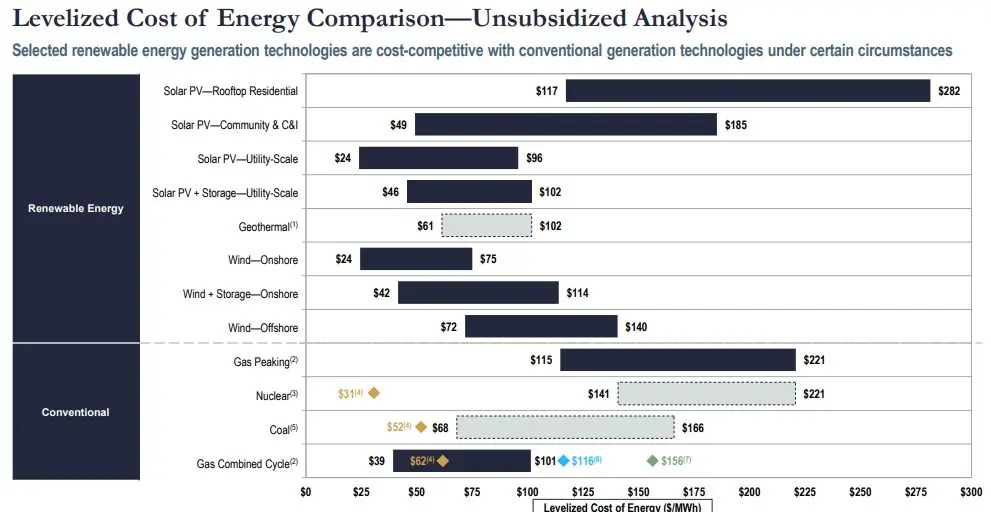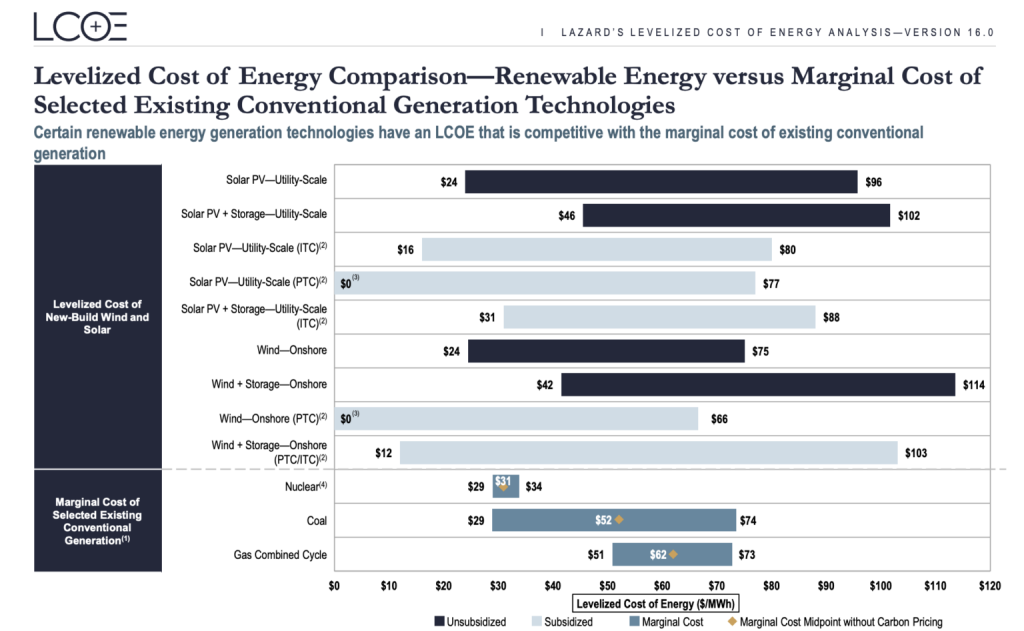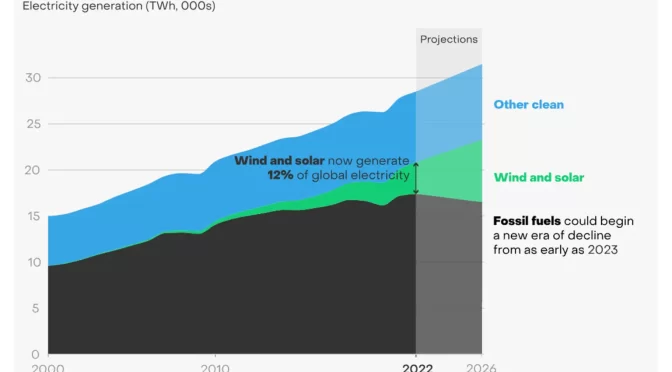There is some question about whether the lofty goals of the Biden administration to promote the adoption of electric vehicles will succeed — they are ambitious — but there is no question that renewable energy — wind and solar — are taking over from thermal generation when it comes to making electricity.
The fourth annual Global Electricity Review from independent energy think tank Ember is out and it has nothing but good news for fans of wind and solar energy. The first finding in this year’s report is that the carbon intensity of global electricity generation fell to a record low of 436 grams of CO2/kWh in 2022, the cleanest electricity ever. This was due to record growth in wind and solar, which reached a 12% share of the global electricity mix, up from 10% in 2021. Together, all clean electricity sources (renewables and nuclear) reached 39% of global electricity, a new record high.
Solar generation rose by 24%, making it the fastest growing electricity source for 18 years in a row. Wind generation grew by 17%. The increase in global solar generation in 2022 could have met the annual electricity demand of South Africa, and the rise in wind generation could have powered almost all of the UK. Over sixty countries now generate more than 10% of their electricity from wind and solar. However, other sources of clean electricity dropped for the first time since 2011 due to a fall in nuclear output and fewer new nuclear and hydro power plants coming online.

The second major finding in this year’s report is that wind and solar are slowing the rise in power sector emissions. If all the electricity from wind and solar instead came from fossil generation, power sector emissions would have been 20% higher in 2022. The growth alone in wind and solar generation (+557 TWh) met 80% of global electricity demand growth in 2022 (+694 TWh).
Clean power growth is likely to exceed electricity demand growth in 2023. This would be the first year for this to happen outside of a recession. Ember says that “with average growth in electricity demand and clean power, we forecast that 2023 will see a small fall in fossil generation (-47 TWh, -0.3%), with bigger falls in subsequent years as wind and solar grow further. That would mean 2022 hit ‘peak’ emissions. A new era of falling power sector emissions is close.” (emphasis added)
Ma?gorzata Wiatros-Motyka, senior electricity analyst for Ember, sums it up succinctly: “In this decisive decade for the climate, it is the beginning of the end of the fossil age. We are entering the clean power era. The stage is set for wind and solar to achieve a meteoric rise to the top. Clean electricity will reshape the global economy, from transport to industry and beyond. A new era of falling fossil emissions means the coal power phasedown will happen and the end of gas power growth is now within sight. Change is coming fast. However, it all depends on the actions taken now by governments, businesses and citizens to put the world on a pathway to clean power by 2040.”
Wind & Solar LCOE Numbers Don’t Lie


Lazard, which specializes in financial advice and asset management, conducts a regular revue of what is known in the utility industry as the levelized cost of energy. For those who may not know exactly what that means, here is how the folks at Wikipedia explain it:
“The levelized cost of electricity (LCOE) is a measure of the average net present cost of electricity generation for a generator over its lifetime. It is used for investment planning and to compare different methods of electricity generation on a consistent basis.
“The LCOE ‘represents the average revenue per unit of electricity generated that would be required to recover the costs of building and operating a generating plant during an assumed financial life and duty cycle’, and is calculated as the ratio between all the discounted costs over the lifetime of an electricity generating plant divided by a discounted sum of the actual energy amounts delivered.
“Inputs to LCOE are chosen by the estimator. They can include the cost of capital, decommissioning, fuel costs, fixed and variable operations and maintenance costs, financing costs, and an assumed utilization rate.”
Some might refer to it as the bottom line. Taking all relevant factors into account, how much does it cost to generate the electricity we use to power our world?
The latest LCOE study from Lazard says it clearly — renewable energy from wind and solar resources is cheaper than electricity from thermal generators powered by coal, oil, or methane gas. Period. Full stop. (See the chart above.)
The latest report focuses on the United States but Australia’s Renew Economy says the results are applicable to most global markets as well. Its findings show renewables like wind and solar out-compete coal, oil, and gas even when utility scale storage is taken into account. Lazard has been saying the same thing since 2019.
Renew Economy can be a trifle snarky at times, and deservedly so. “It is now well understood by all bar Sky News viewers in Australia that wind and solar offer by far the cheapest form of generation, even when ‘firmed’ by storage and including transmission costs. This is critically important given that Australia has to replace its ageing and increasingly decrepit coal plants, even if climate change was not a factor.” For those who don’t live Down Under, Sky News is to Oz what Fox News is to America and has the same owner.
The Power Of Policies
The Lazard assessment shows that by virtually any assessment — cost of energy, cost of energy and firming, marginal cost of energy, and cost of capital — wind and solar win easily. And that’s without counting the carbon cost of their competitors and the impact of the Joe Biden’s Inflation Reduction Act, which has added tens of billions of new financial incentives to the mix.
“The central findings show, among other things, that even in the face of inflation and supply chain challenges the LCOE of best in class renewables continues to decline,” Lazard notes.
The Takeaway
Reactionaries are always screaming about the free market and a level playing field. Well, the proof is in the pudding. If anyone builds new generating capacity that is powered by coal, oil, or coal, it is like pissing money away and costing ratepayers dearly. (Forget about nuclear, whose LCOE is many multiples of wind and solar.)
The Ayn Rand free market types will have to find some other reason to oppose wind and solar. These numbers don’t lie. The least expensive electricity comes from wind and solar. The fact that it also lowers carbon emissions dramatically is just the icing on the cake.
Written BySteve Hanley
Steve writes about the interface between technology and sustainability from his home in Florida or anywhere else The Force may lead him. He is proud to be “woke” and doesn’t really give a damn why the glass broke. He believes passionately in what Socrates said 3000 years ago: “The secret to change is to focus all of your energy not on fighting the old but on building the new.”
BySteve Hanley, cleantechnica.com


